
(Original photography by IBTIHAL)
Chefchaouen, often referred to as the “Blue Pearl Chefchaouen” is one of the most beautiful and mesmerizing cities in North Africa. Nestled in the western part of the Rif region in northern Morocco, it is surrounded by the majestic Rif Mountains, which provide a stunning natural backdrop.

(The door symbolizes the entrance of the city)
(Original photography by IBTIHAL)
The name Chefchaouen (شفشاون) is derived from the Berber language which is believed to come from the word “Chau ⵛⵓ”, which means “Horns”. This refers to the shape of the mountains that surround the city: Tisouka and Megou mountains. Chefchaouen roughly translates to “Look at the Horns”.
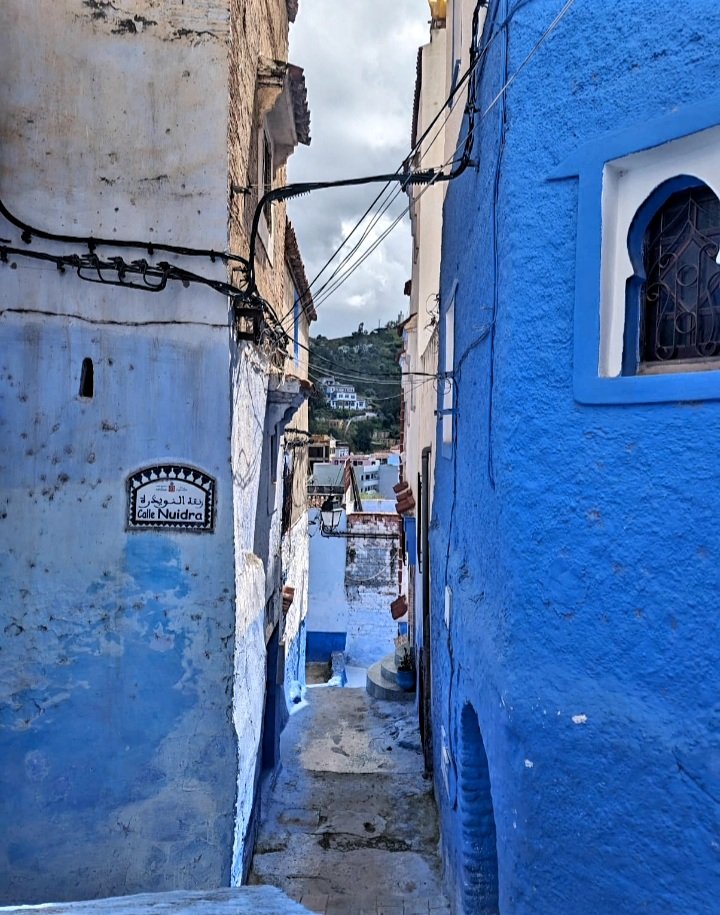
(Name of the Street mentioned in Arabic and Spanish languages)
(Original photography by IBTIHAL)
This city is celebrated for its unique architecture, rich history, cultural heritage, traditional handicrafts, and warm, welcoming people. Founded in 1491, Chefchaouen experienced a major transformation after the fall of Granada in the 1600s, when an influx of intellectual Arabs and Andalusians fled Spain and settled in the area.
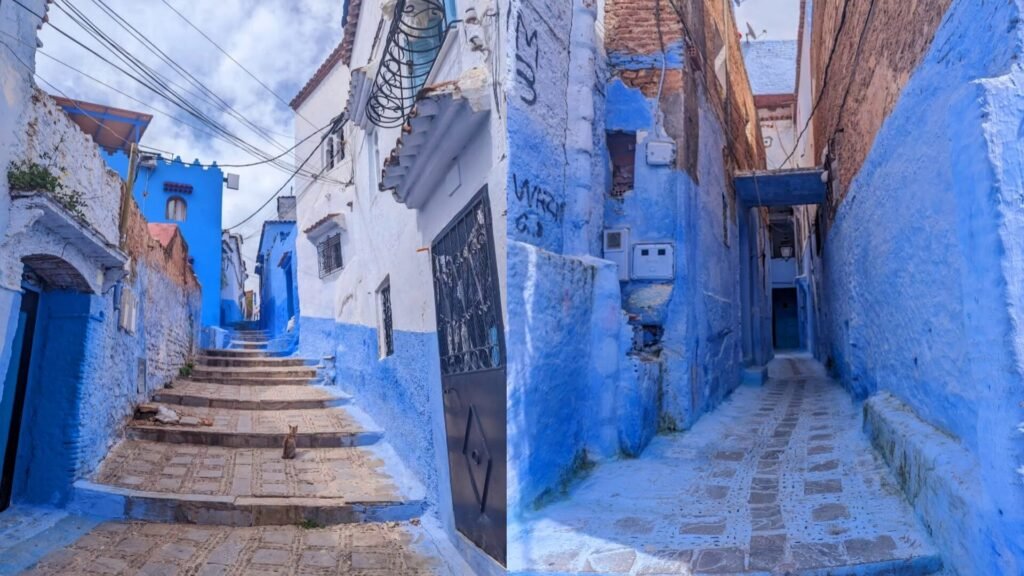
(Original photography by IBTIHAL)

(Original photography by IBTIHAL)
THE BLUE CITY: CHEFCHAOUEN’S ARCHITECTURE AND COLOR EVOLUTION

(Original photography by IBTIHAL)
Chefchaouen’s architecture is deeply rooted in Arabic-Andalusian traditions, with early structures predominantly painted in white. The iconic blue hue that defines the city today is thought to have been introduced by Jews who migrated from Spain. According to some theories, they added the blue color to buildings after their arrival. Initially, blue appeared only in small patches, particularly in the narrow streets, while the city remained largely white.

(Original photography by IBTIHAL)

(Original photography by IBTIHAL)
Over time, various theories emerged about why this blue-and-white combination became so prominent. Some suggest it was practical—blue is believed to repel mosquitoes at night, acting as a natural pest deterrent. Others argue that the shift to blue helped the city stand out, making it visually unique and thus more appealing to tourists. Whatever the reason, the vibrant colors undoubtedly boosted the city’s popularity as a travel destination.

(Original photography by IBTIHAL)
In the 1980s and 1990s, the blue shade began to evolve, shifting from subtle tones to the vivid, almost electric blue seen today. This transformation marked a departure from the original hues, solidifying Chefchaouen’s reputation as a strikingly beautiful and culturally distinctive city. While the true reasons for its blue palette remain uncertain, the city’s charm and allure are universally acknowledged.

(Original photography by IBTIHAL)
MUST-SEE SPOTS:
Plaza Uta El-Hammam
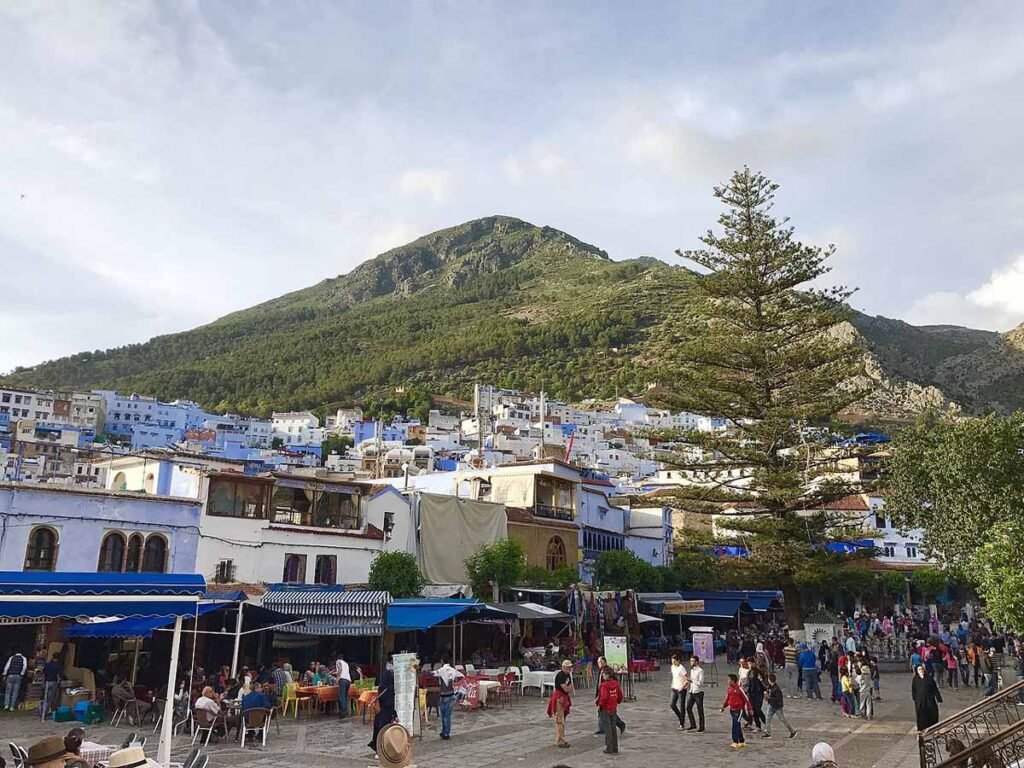
Uta El-Hammam Square is the largest in Chefchaouen, once a commercial hub connecting key landmarks like the Great Mosque, Kasbah, and shops. The central fountain provided water for locals and visitors. Today, it’s a relaxing spot to enjoy local cuisine, mint tea, and the surrounding views, with the Great Mosque nearby for prayer.

Kasbah
Once a fortress, the Kasbah is now a museum and Andalusian garden. Renovated over the centuries, it offers panoramic views of the city, making it a popular tourist attraction.

(Original photography by IBTIHAL)
Place El Haouta Square

Smaller yet more vibrant than Uta El-Hammam, Place El Haouta is surrounded by cafes and artistic shops, creating a lively atmosphere perfect for shopping and relaxation.
Ras El-Maa & Rif Mountains

(Original photography by IBTIHAL)
Ras El-Maa is a peaceful spot where you can admire blue buildings, waterfalls, and cascades. Historically, women used to wash their clothes here by the stream.

(Original photography by IBTIHAL)

(Original photography by IBTIHAL)
Nearby, the Jamaa Bouzafar Mosque, with its distinct architecture, adds to the beauty of the area. Many tourists visit this mosque to watch the stunning sunset, often accompanied by local musical performances.

(Jamaa Bouzafar Mosque, Original photography by IBTIHAL)
You can even enjoy the beautiful atmosphere while enjoying tea at restaurants nearby.

(Original photography by IBTIHAL)

(Original photography by IBTIHAL)
Akchour Waterfalls

Located about 30 minutes from Chefchaouen, the Akchour waterfalls are a must-see for nature lovers. The scenic hike takes you through lush forests and rocky paths, leading to two main spots: The Petit Cascade and the Grand Cascade. Along the way, you’ll find small cafés by the river where you can rest with mint tea. It’s a peaceful escape from the city’s buzz, perfect for a half-day adventure in the Rif Mountains.

Route de Tissemlal
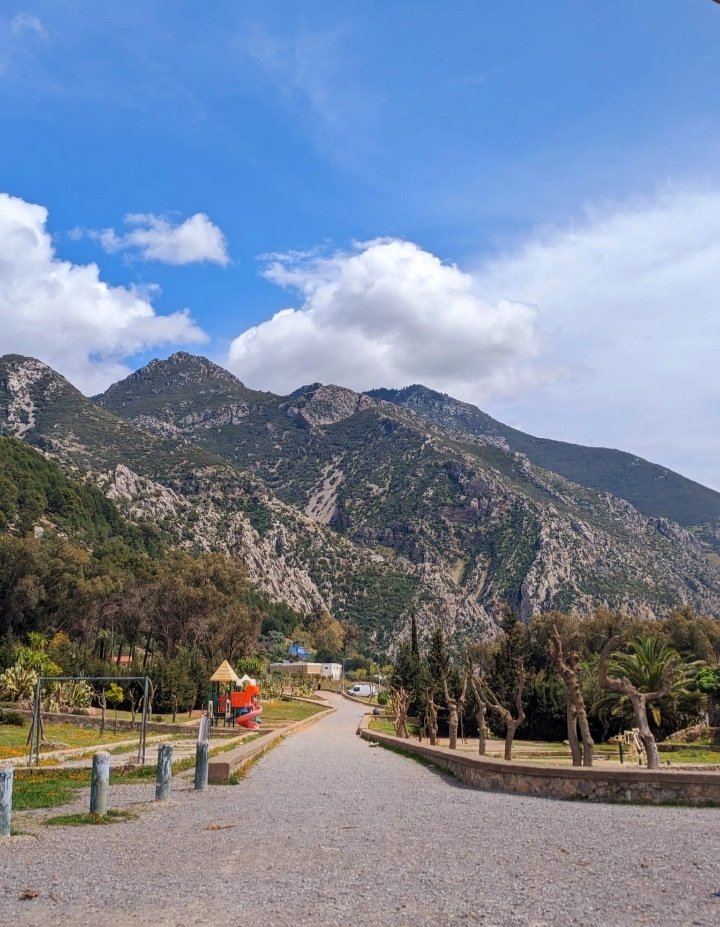
(Original photography by IBTIHAL)
When we talk about Route de Tissemlal, it is a high mountain route located in the Rif Mountains. Its highest point is at 1.745m above the sea level. The name Route de Tisemlale is inspired from the Berber language which means ‘Cold Spring’.

(Original photography by IBTIHAL)
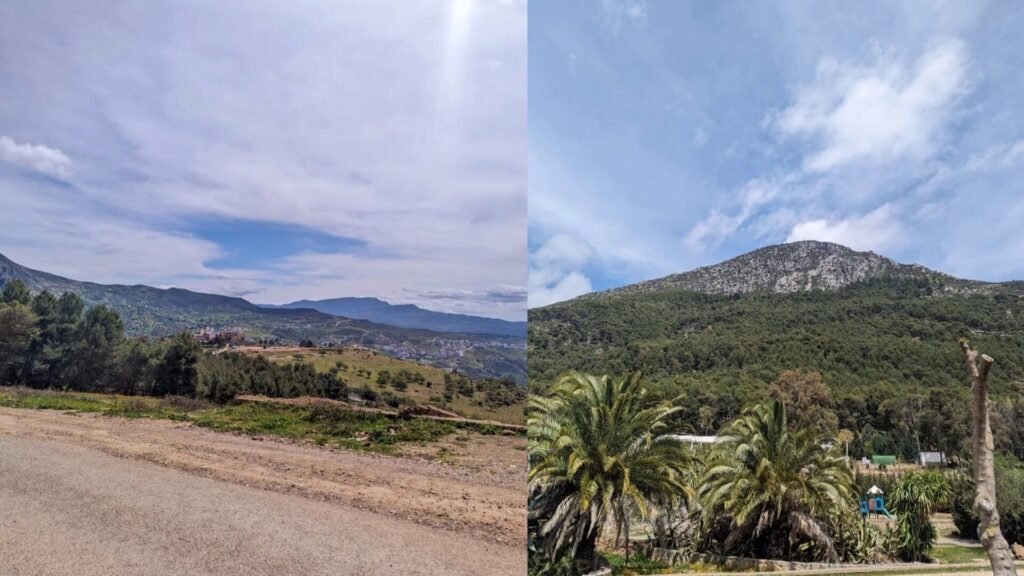
(Original photography by IBTIHAL)
With its splendid and mesmerizing landscapes, plants and rare animal species, Tissemlal national park is a dream site for the ecological tourists. Apart from that, it also attracts tourists from all over because of its cool atmosphere even during the hot summers in the rest of the country.

(Original photography by IBTIHAL)
LOCAL CUISINE & HANDICRAFTS:

(Original photography by IBTIHAL)
Chefchaouen offers a delightful taste of authentic Moroccan cuisine with a local twist. The region is known for its creamy goat cheese, often served with warm bread and olives as a starter. Traditional dishes like slow-cooked tagines, Tagra, Bissara, Harira soup, and Couscous are staples, often infused with aromatic herbs from the Rif mountains. Don’t miss sipping on fresh mint tea while watching life go by in the medina.

(Original photography by IBTIHAL)
The image showcases a beautifully handcrafted traditional headpiece from Chefchaouen, Morocco, commonly worn by women of the Rif region. The rich red fabric is adorned with intricate beadwork, sequins, and decorative elements, including a triangular beaded motif and the embroidered name “شفشاون” (Chefchaouen) in sparkling stones. This ornamental headpiece is typically worn beneath the straw chachia hat and is an important part of regional Amazigh (Berber) cultural attire. It reflects the wearer’s heritage and is often used in festive or ceremonial settings to express identity, pride, and tradition.

(Original photography by IBTIHAL)

(Original photography by IBTIHAL)
Beyond food, Chefchaouen is also a hub for artisans. The souks are filled with handwoven blankets, colorful wool garments, leather goods, and intricate pottery. Everything reflects the town’s Andalusian and Berber heritage. Buying from local makers not only brings home a unique piece of the town, but also supports the community.

(Original photography by IBTIHAL)

(Original photography by IBTIHAL)
Tucked within the winding blue streets of Chefchaouen, the Sabanin Oven is more than a bakery—it’s a living piece of history. For centuries, neighbors have brought their dough here, letting the warmth of the fire and the rhythm of tradition turn it into bread, into memory, into community.

(Original photography by IBTIHAL)
WHISKERS OF CHEFCHAOUEN

(Original photography by IBTIHAL)
In Chefchaouen, the cats seem to belong to the city itself: graceful, curious, and unhurried. As you wander the blue streets, they’ll cross your path, sometimes lingering for a soft scratch or a playful meow.

(Original photography by IBTIHAL)
Interacting with them isn’t just a moment! It’s a quiet, joyful memory that stays with you long after you’ve left, a reminder of the city’s gentle charm.

(Original photography by IBTIHAL)
This is the entrance of the cemetery where true sons of the soil, and legends of the past are sleeping who once served their golden time to flourish this beautiful piece of land on earth.

(Original photography by IBTIHAL)
SUSTAINABLE & RESPECTFUL TOURISM:

(Original photography by IBTIHAL)
As Chefchaouen grows in popularity, so does the responsibility of preserving its charm. The blue walls that attract thousands of visitors need careful maintenance, and over-tourism can strain local resources. Travelers are encouraged to be mindful: stay in locally owned guesthouses, eat at family-run restaurants, and avoid littering or damaging the iconic painted streets.

(Original photography by IBTIHAL)
Respect for local culture is also key—ask before taking photos of people, dress modestly, and engage with the town’s rhythm rather than rushing through it. Sustainable tourism ensures that the magic of Chefchaouen can be enjoyed by future generations while benefiting those who call it home.
PERSONAL REFLECTIONS & TRAVEL TIPS:
The best time to visit Chefchaouen is between March and June. Spring brings mild weather, blooming nature, and fewer crowds—unlike winter, which can be surprisingly cold, or summer, when the heat becomes intense.

(Original photography by IBTIHAL)
When visiting, it’s important to support the local community. Stay in family-run riads, buy handmade crafts, and eat at local spots. Your choices help preserve the town’s charm and sustain its people.

(Original photography by IBTIHAL)
But above all, take your time. Wander the blue alleys, breathe in the unique scent of the city—an earthy blend of spices, fresh mountain air, and the faint smell of pine, feel the history in the walls, and let yourself get lost in the colors and calm. Chefchaouen isn’t just a destination—it’s an experience meant to be enjoyed slowly.
A JOINT ARTICLE
BY
IBTIHAL & NABEEL RASHID
NOTE: We are thankful to the following for the research work.
https://www.journalofnomads.com/akchour-waterfalls-chefchaouen
https://www.viator.com/tours/Tangier/Chefchaouen-and-Akchor-day-trip-from-Tangier/d4388-10195P61?dd_referrer=https%3A%2F%2Fwww.google.com%2F
https://brainybackpackers.com/akchour-waterfall
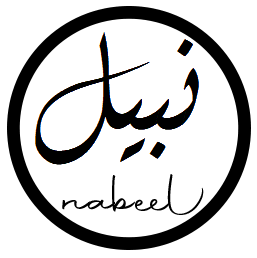
Lovely piece of write up. Really enjoyed reading it.
Nice article… and beautiful photography. Loved the article.
Very well written article.. I loved the flawless writing style along with the mesmerising photography..
Only a local can give such a beautiful information along with pics. Well done Ibtihal. The Photographer…